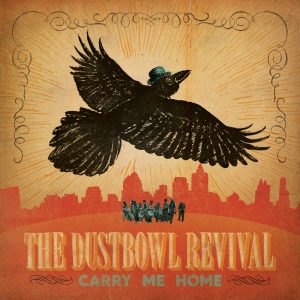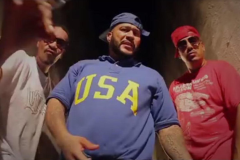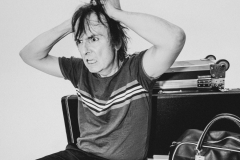From The Horse's Mouth: Zach Lupetin (The Dustbowl Revival) on Carry Me Home
The spirit of the West is alive and well in the music of Los Angeles-based roots music collective The Dustbowl Revival. This rambling, rolling spirit is the same spark that lit a fire under the past two centuries of Westward migration in America. It comes from a need for wide-open vistas, rollicking street parties, laidback lifestyles, and communities that you build yourself.
For the folks in The Dustbowl Revival, West Coast living suits them just fine. Their high-spirited blend of old school bluegrass, gospel, jug-band, swamp blues, piercing brass blasts, and the hot swing of the 1930s has made them one of the hottest roots music bands in LA and garnered them praise from the likes of tastemaker radio station KCRW, the Los Angeles Times, and alt-paper the LA Weekly.
The Dustbowl Revival’s new album, Carry Me Back brings a raucous energy rare to bands of this ilk. Their gin-soaked approach is the thing all night parties are made of. Ghettoblaster recently chatted with bandleader Zach Lupetin about the LP. This is what he said about it…
When did you begin writing the material for your most recent album?
Many of the tunes that made it onto Carry Me Home LP have been in the band consciousness or mine for some time – some we have been playing live and honing for years, a few others like “Mayflower” and “Barnacles” we have almost never played and were sort of hidden-away demos that I thought would be a fun addition to the record.
What was the most difficult song to take from the initial writing stage through recording and mixing? Why was it so troublesome?
I’d say the hardest part of about recording is that you can often feel great about the feel and sound of a song in the moment – and then six months later realize that it may be too fast or two rowdy or not quite how you envisioned it! But there’s new discoveries that come through too. Achieving the visceral, live flavor of the gang-vocals on “John The Revelator,” “Never River Train,” and “Riverboat Queen”, and the emotive nuance on “Swing Low” was a real challenge. Eric Lilavois and his team at Crown City Studios did a good job of tweaking and massaging without losing the warm, old fashioned sound I always try and find.
Which of the songs on the record is most different from your original concept for the song?
There was a bigger, brasher sound on this record that I wanted to achieve. I really think it’s hard to try and nail the exact sound you dream a song to have in your head. What I think you can do is capture the essence, the energy. An ideal Dustbowl show should have a lot of dynamics to it – the controlled joyous chaos of a brass band going full tilt, the spareness of a gospel choir, fiddle and mandolin battles leading to a hoedown – I think we captured a lot of that on this record. I really do like how “Hard River Gal” turned out – much more full and fat than the weird little country ditty I first laid down in my bedroom.
Did you have any guest musicians play or sing on the record?
We have a great community of roots and jazz players in the LA area that team up on our records. We had awesome LA accordionist and professor Gee Rabe back as well as Raymond Richards (who recorded our previous album Holy Ghost Station) on pedal steel, Mark San Filippo came in on drums, Paul Cartwright on fiddle (“Soldier’s Joy”), Kate Nicholsen on tasty harmony vocals and the boys in local folk trio The Song Preservation Society – (as well as a handful of friends) really helped out with our gang vocals. It was a small army to say the least – twenty seven folks or so.
Who produced the record? What input did that person have that changed the face of the record?
Eric Lilavois at Crown City Studios in Pasadena and his crew spent a lot of time over many months humoring me and trying things out. They were very accommodating in trying to match the vision I tried to set forth – naturally things change in the moment but overall, Eric really understood the sort of new-old time sound we were going for. Without his guidance, I don’t think the album sounds as big and full as it does.
Is there an overarching concept behind your new album that ties the record together?
As a lyricist I am intrigued with stories that often have a darker twist to them – sometimes it’s about bringing humor and unexpected plot jumps into a song that makes it memorable. In our blip culture you have so little time to grab your audience and keep them with you. I love that moment at a show when a person in the crowd who is checked out and barely paying attention to the music snaps to attention – it’s like a conversation directly from you to the listener and it’s electric. Carry Me Home came together organically – many of the songs were recorded months apart as we were inspired to record them. Honoring and reshaping traditional bluegrass, swing and gospel tunes is something I have become passionate about – I wanted to merge these kind of tunes that people grew up with – with new, original stories that somehow came from the same place. It can get a little messy but I think bringing the two together is worth it.
Have you begun playing these songs live and which songs have elicited the strongest reaction from your fans?
A few of the tunes we are just trying out live now. We actually tried out the tune “Josephine” for the first time about a year back at a comedy show. It was one of those bizarre, spur of the moment tunes that gets stuck in your head and won’t quit. The beauty of having a band that’s up for anything is that you can hum a few lines of a new song a few days after you wrote it in the shower and next thing you know – it’s the most fun song in your set and it takes on a life its own! It felt so good at that little comedy show that we started doing it ever since. It gets requested at every show!









Social Media